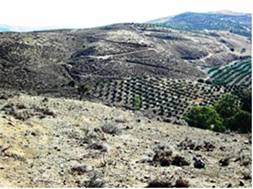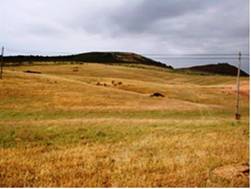Subsidies
This indicator aims to assess how the structure of CAP support influences the choice of farmers in terms of agricultural land use and land management practices. However, European Union farm subsidies support has ensured an adequate income to farmers for maintaining landscapes especially in less favoured areas, but this support has favoured the intensification and specialisation process in agriculture by applying more fertilizers, pesticides, irrigating of the land, increasing the number of animals, etc. Under this financial support, unproductive agricultural areas cultivated with cereals, critical to desertification, have remained under cultivation; further deteriorating soil conditions (Fig. 97). Number of animals has increased in unsustainable number causing severe degradation in vegetation and soils (Fig. 97).


Fig. 97. Typical examples of overgrazing (left, Crete) and unproductive agricultural area cultivating with cereals (right, Portugal) highly degraded due to existing policies for subsidy support
Based on the new CAP, additional funds are available as a donation for people who apply measures for protection or improvement of the environment, and/or for improvement of the quality of the agricultural products. The support has been included in the so called "Integrated System". The system is implemented in the actions such as: compound support, special funding for the quality of the durum wheat, funding for the nutritious seeds, special support for rice, support for cultivation of plants for energy production, funding for the milk production and extra support, special support for cotton, support/1000 m2 of the traditional olive orchards, production of durum wheat and corn, production of tobacco, production of olive oil and table olives, sugar beet production, beef meat production, sheep and goats feeding, etc.
This indicator have been classified for the purpose of this project in the following categories: (a) no subsidies, (b) subsidies for environmental protection, (c) subsidies for production provided in the basis of area cultivated, number of animals per farmer, amount of production, etc. Data have been collected from the local administration related to institutional characteristics of the study field sites.
As Table 15 shows, data for the indicator "subsidies" have been collected for 1056 study field sites, corresponding to 10 study sites. The analysis of the data have shown that allocation of subsidies for production have been identified in 64.6% of the study sites, corresponding to all field sites of the study sites of Djanybek-Russia, Guadalentin Basin Murcia-Spain, Eskisehir-Turkey, Konya Karapinar plain-Turkey, Cointzio Catchment-Mexico, and Crete-Greece, and in some cases in the study sites of Boteti Area-Botswana, and Zeuss Koutine-Tunisia. No subsidies allocation have been defined in 25.5% of the study field sites, corresponding to all field sites of Novij Saratov-Russia, and Mamora Sehoul-Morocco, and in some field sites of Zeuss Koutine-Tunisia, and Santiago Island-Cape Verde. Subsidies allocated for environmental protection have been identified only in 9.9% of the study field sites, corresponding to the study sites of Zeuss Koutine-Tunisia, Secano Interior-Chile, and Santiago Island-Cape Verde.

Fig. 97. Distribution of subsidies categories allocated for environmental or production purposes in the study field sites